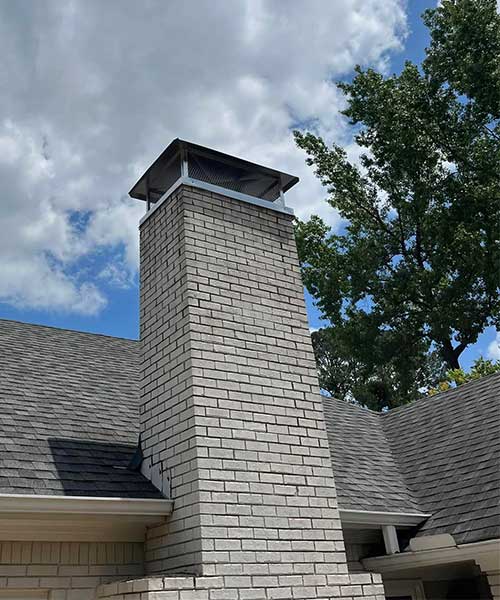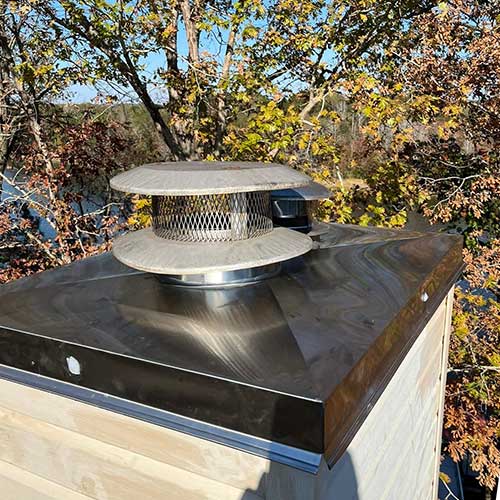Masonry Repair Near Me: Trust Birmingham Chimney in Vestavia Hills & Surrounding Areas
When cracks, crumbling mortar, or damaged bricks appear in your chimney or fireplace, it’s not just a cosmetic issue (although it can take a toll on your home’s curb appeal). Masonry damage is also a sign that your chimney needs some professional care and attention. At Birmingham Chimney, we specialize in reliable chimney masonry repair services near you for homeowners in Vestavia Hills and the surrounding Birmingham area.
Chimney Masonry Repair Services: What Do We Offer?
Our team combines years of hands-on experience with industry-trusted techniques to restore the strength, safety, and beauty of your masonry structures. We know that proper masonry repair services can make all the difference in how well your system functions, which is why Birmingham Chimney offers fireplace solutions designed to keep your chimney stronger, safer, and looking its best. Trust us for:
- Tuckpointing & Repointing: We carefully remove damaged mortar and replace it with new, matching material to restore stability and prevent future water intrusion.
- Brick & Stone Replacement: If bricks or stones have cracked, spalled, or fallen away, we replace them with high-quality matches to maintain strength and appearance.
- Chimney Crown Repair & Rebuilds: We repair cracks, rebuild deteriorating crowns, and apply waterproof sealants to stop leaks before they reach your home.
- Firebox Repair & Rebuilds: Our team repairs or rebuilds fireboxes to ensure safer operation and restore the heart of your fireplace.
- Smoke Chamber Parging: Rough or damaged smoke chambers can restrict airflow and increase fire risk, so we parge coat surfaces for smoother drafting.
- Waterproofing & Leak Prevention: We apply professional-grade waterproofing treatments that protect your chimney without changing its natural look.
From small cracks to full structural rebuilds, our masonry services are designed to extend the life of your chimney.

What Is Tuckpointing? How Often Do I Need Tuckpointing?
Mortar is naturally softer than brick… And while that allows the structure to “breathe” and expand without damage, it also means that your mortar won’t last as long as the bricks themselves. Over time and after exposure to rain, snow, wind, and temperature swings, the mortar that holds your bricks together will wear down, shrink, crack, or crumble.
Does that mean a rebuild will be in order? Absolutely not. This is where tuckpointing comes in.
Tuckpointing is the process of carefully removing deteriorated mortar and replacing it with fresh, durable material that matches both the color and texture of the original mortar. When done correctly by professional masons, this process restores the strength of the chimney, prevents water intrusion, and greatly extends the lifespan of your masonry…all without needing to tear anything down or rebuild it.
The frequency that you’ll require tuckpointing services depends on several factors:
- Age of the chimney: Older chimneys tend to need more frequent maintenance since their mortar is more likely to have weakened over the decades.
- Climate: Areas with harsher freeze-thaw cycles may warrant more frequent tuckpointing, which is good news for us in Birmingham, as our winters tend to be more mild.
- Weather changes: Although temperature fluctuations aren’t extreme here, weather conditions can vary year to year – harsher seasons may warrant more repairs.
- Previous repairs: If your chimney has been poorly repaired in the past, the mortar may fail sooner than expected…which is why trusting an expert from the start is so important!
In general, most homeowners can expect to need tuckpointing every 20-30 years. However, inspections should be performed once a year to ensure everything stays in tip-top shape. A professional sweep or mason can spot early signs of mortar deterioration long before they turn into leaks or structural problems.
All in all, tuckpointing is an investment in both safety and appearance, adding curb appeal to your home and helping to maintain your property’s value. Putting off tuckpointing may seem harmless, but even small gaps in mortar joints can lead to big problems, so don’t put this service off.
Is tuckpointing the same as repointing?
The term “tuckpointing” is sometimes used interchangeably with “repointing,” and while they’re similar, there are some slight differences between the two. Repointing simply means replacing the damaged mortar with new mortar, which tuckpointing involves applying a second, fine line of contrasting mortar to give the illusion of clean, sharp joints. This technique has aesthetic benefits as well as structural ones.
How Does Water Damage Chimney Masonry?
Not-so-fun fact: Water is the biggest enemy of masonry chimneys. While brick and mortar appear to stand strong and solid against rain and sleet, they are actually porous materials that absorb moisture. Over time, this constant exposure takes a toll on the structure, causing both cosmetic and structural issues.
One of the most destructive of these processes is the freeze-thaw cycle. Here’s what happens:
- When water enters tiny cracks or pores in the brick and mortar, it sits there until temperatures drop below freezing.
- As water freezes, it expands, putting pressure on the surrounding material and causing cracks to form.
- When it thaws, the material contracts, leaving space for more water to enter before the next freeze/thaw cycle.
As we’ve mentioned, freeze/thaw cycles aren’t a major worry for us in the northern part of Alabama, but it does happen…and we should be doing everything we can to protect our masonry structures against it, as this repeated cycle can take atoll. Left unchecked, the spalling that occurs can result in missing bricks, crumbling mortar joints, and major structural weakness.

Water also causes visible cosmetic damage. When moisture seeps into masonry and then evaporates, it leaves behind white, powdery salt deposits known as efflorescence. While not harmful in itself, efflorescence is a sign of water movement through the masonry – in other words, leaks and deterioration may be occurring elsewhere. Persistent water intrusion can also cause dark stains, moss, or mildew growth on the chimney’s exterior.
And remember that water that seeps into chimney masonry doesn’t always stay outside. It can trickle down into your fireplace or chimney system, causing rust on damper components, deterioration of flue liners, and unpleasant odors. Moisture inside the system can also mix with creosote, forming a thick, corrosive substance that accelerates flue damage.
Water damage in chimneys doesn’t fix itself. Even small cracks can let in enough moisture to cause serious problems over time, not just for your fireplace, but for surrounding areas of your home. What starts as a few loose bricks or a white powdery stain may eventually lead to a full chimney rebuild. So, don’t wait! If your masonry is facing water damage, reach out to our team right away.
How Can I Protect My Chimney Masonry?
Since water is the number-one cause of chimney deterioration, protecting your masonry is all about prevention. Fortunately, there are several proven ways to safeguard your chimney and extend its lifespan.
- Schedule Annual Inspections: The most effective protection begins with regular chimney inspections, when a CSIA-certified technician can identify early signs of mortar cracks, brick spalling, or water leaks long before they become major repairs.
- Waterproofing Treatments: One of the best defenses against water damage is professional masonry waterproofing. Unlike paint or sealants that trap moisture inside, chimney waterproofing products are breathable, helping your brick repel rain and snow, while allowing water vapor to escape from within.
- Chimney Crown Protection: The chimney crown is the concrete or masonry slab at the very top of your chimney that helps to send water away from the flue and exterior walls. If the crown is cracked or poorly built, water will seep directly into the chimney, so booking repairs and waterproofing for it is a must.
- Chimney Cap Installation: A simple, but highly essential, chimney feature is the chimney cap. It’s essentially a metal cover that fits over the top of the flue, preventing rain, snow, and debris from entering. Chimney caps also keep out animals and reduce downdrafts.
- Tuckpointing & Repointing: When mortar joints start to fail, prompt tuckpointing or repointing restores their strength and helps prevent water from seeping back in. Waiting too long can allow deterioration to spread, so if you see areas crumbling, call us as soon as possible.
- Flashing Maintenance: In the vulnerable spot where the chimney meets the roof, metal flashing can be installed to seal the gap and prevent leaks. Damaged, rusted, or poorly installed flashing is a common source of chimney water damage.
Preventive maintenance can feel like a bit of a hassle at the time, but a few easy steps will not only save you money on repairs later on, but also ensure your chimney remains safer for use. In addition, protected chimneys last decades longer, draft more effectively, and look better from the curb.
Turn To Us for Chimney Services
Don’t let minor cracks turn into major problems. Trust Birmingham Chimney for high-quality masonry repair services that keep your fireplace and chimney safer, more efficient, and looking their best. We’re proud to serve homeowners throughout Vestavia Hills and nearby communities. Call us today to schedule your next masonry repair, and let us help you enjoy peace of mind and a fireplace system that’s built to last.
Ready for a full fireplace changeout? Our team can handle it all with our full list of fireplace services.
